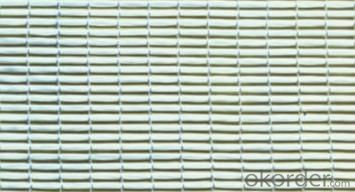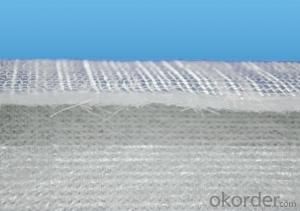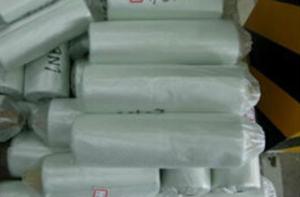Fiberglass Mat Tissue Unidirectional Fabric 600gsm 1000mm
- Loading Port:
- Shanghai
- Payment Terms:
- TT or LC
- Min Order Qty:
- 5000 kg
- Supply Capability:
- 50000 kg/month
OKorder Service Pledge
OKorder Financial Service
You Might Also Like
Structure of Fiberglass Multiaxial Fabric-UD Description:
Fiberglass unidirectional fabric is the product combining the roving in certain angel of 0 ℃ or 90 ℃ with polyester yarn.
Main Features of the Fiberglass Multiaxial Fabric-UD:
• Fiber straight arranged, fiber strength be ultimately used.
• No powder or emulsion, sink quickly, easy to operate.
• Easy to design, high strength in one direction.
Mainly be used as reinforced materials in the composite material industry.
• Matrix: unsaturated polyester resin, vinyl ester resin, epoxy resin and phenolic resin etc.
• Craft: winding, pultrusion, hand lay up, etc.
• Ultimate products: storage tank, tube, pultruded profiles, FRP body of boat, etc.
Fiberglass Multiaxial Fabric-UD Images:


Unidirectional Specification:
specifications | Fibre type | 0°Roving | 90°Roving | Overall weight | Width |
(g/㎡) | (g/㎡) | (g/㎡) | (mm) | ||
EDW227 | E-Glass | — | 227 | 227 | 1524 |
EDW350 | E-Glass | — | 350 | 350 | 1524 |
EDW450 | E-Glass | — | 450 | 450 | 1524 |
EDJ600 | E-Glass | 480 | 120 | 600 | 1524 |
EDJ800 | E-Glass | 600 | 200 | 800 | 1524 |
EDJ1000 | E-Glass | 600 | 400 | 1000 | 1524 |
Packaging: Wrapped in PVC and placed within a cardboard carton. | |||||
FAQ of Chopped strand mat
1. Why Choose us?
CNBM is a stated own company, provide the guarantee for the best quality, best service and safety business.
2. How will we guarantee the quality?
a, ISO 9001-2008 quality control system;
b, Strict and regular quality control in production;
c, Inspeciation when loading into container before shippment;
d, Sample stock for one year for quality tracing and record.
3. What is your MOQ?
Our MOQ is one pallet.
4. Can you provide sample?
Yes, samples are in stock. we can offer free sample for you.
5. Payment terms?
We can accept L/C, T/T etc.
- Q: What is the impact resistance of fiberglass mat tissue?
- The impact resistance of fiberglass mat tissue is quite high due to its inherent properties and construction. Fiberglass mat tissue is composed of fine glass fibers that are randomly arranged and bonded together with a binder material. This arrangement creates a strong and flexible mat that can withstand impacts and external forces. The random orientation of the glass fibers allows for the distribution of stress and energy across the entire mat tissue. When an impact is applied, the fibers absorb and disperse the force, preventing it from being concentrated in one area. This property helps to minimize the risk of cracks, fractures, or failures in the material. Additionally, the binder material used in fiberglass mat tissue provides further reinforcement and cohesion to the structure. It acts as a bonding agent, keeping the glass fibers in place and enhancing their overall strength. This bonding ensures that the mat tissue remains intact and resilient even under high impact loads. Due to its excellent impact resistance, fiberglass mat tissue is commonly used in various applications where durability and strength are essential. It is often utilized in the manufacturing of composite materials, such as fiberglass-reinforced plastics (FRP), to enhance their impact resistance and structural integrity. It is also frequently employed in the construction industry for applications like roofing, wall insulation, and soundproofing, where it provides protection against impacts and external forces. Overall, the impact resistance of fiberglass mat tissue is a key characteristic that contributes to its widespread use in numerous industries. Its ability to withstand impacts and distribute forces makes it a reliable material for applications that require strength, durability, and protection against external forces.
- Q: Can fiberglass mat tissue be used for insulation in underground pipelines?
- Yes, fiberglass mat tissue can be used for insulation in underground pipelines. Fiberglass mat tissue is known for its excellent thermal insulation properties and is commonly used in various industrial applications, including underground pipelines. It provides insulation by preventing heat transfer between the pipeline and the surrounding environment, thus helping to maintain the desired temperature inside the pipeline. Additionally, fiberglass mat tissue is resistant to moisture, chemicals, and corrosion, making it an ideal choice for underground applications where pipelines are exposed to harsh conditions. Overall, fiberglass mat tissue is a reliable and effective insulation material for underground pipelines.
- Q: Can fiberglass mat tissue be used for pipe wrapping?
- Pipe wrapping can indeed utilize fiberglass mat tissue, a lightweight and flexible material extensively employed in reinforcing and safeguarding various structures, including pipes. The primary purpose of fiberglass mat tissue is to enhance the pipes' strength and durability, thereby rendering them more resilient to damage and corrosion. Wrapping the pipe with fiberglass mat tissue is a simple process that creates a protective layer, effectively preventing leaks and prolonging the pipe's lifespan. Moreover, fiberglass mat tissue is renowned for its remarkable insulation properties, contributing to the maintenance of the contents' temperature as they flow through the pipe. Consequently, fiberglass mat tissue serves as a suitable material for pipe wrapping and finds widespread application across diverse industries.
- Q: Can fiberglass mat tissue be used for insulating radiant floors?
- Yes, fiberglass mat tissue can be used for insulating radiant floors. It is an effective insulation material that helps to minimize heat loss and improve energy efficiency in radiant floor heating systems.
- Q: Can fiberglass mat tissue be used for insulation in cold climates?
- Yes, fiberglass mat tissue can be used for insulation in cold climates. Fiberglass is known for its excellent thermal insulation properties, making it a popular choice for insulating buildings in colder regions. The fiberglass mat tissue is designed to trap air pockets within its structure, which helps to prevent heat transfer and retain warmth inside the building. It is a cost-effective and efficient solution for insulating walls, roofs, and floors in cold climates, providing effective thermal insulation and reducing energy consumption for heating. Additionally, fiberglass is resistant to moisture and does not lose its insulation properties even when exposed to extreme cold temperatures. Overall, fiberglass mat tissue is a suitable option for insulation in cold climates due to its thermal insulation capabilities, durability, and moisture resistance.
- Q: What about high temperature fiberglass?
- Yes. Glass fiber should be bought or broken. Because very thin, eat in, of course not good, but can not digest, theory can be discharged.The temperature does not break the glass fiber but softens and breaks it first. It needs 600 degrees or more!
- Q: Can fiberglass mat tissue be used for making lightweight partitions?
- Yes, fiberglass mat tissue can be used for making lightweight partitions. Fiberglass mat tissue is a lightweight material that is made from fine fibers of glass. It is known for its strength, durability, and flexibility, making it a suitable choice for constructing partitions. When used for making partitions, fiberglass mat tissue can be layered between other lightweight materials such as gypsum boards or plywood to provide additional strength and stability. The fiberglass mat tissue acts as a reinforcement layer, preventing cracks and increasing the overall structural integrity of the partition. Furthermore, fiberglass mat tissue has excellent fire-resistant properties, which is a crucial factor when constructing partitions. It helps to contain fire and prevent its spread, ensuring the safety of the occupants. In addition to its strength and fire resistance, fiberglass mat tissue also offers sound insulation properties. It can help to reduce noise transmission between different areas, making it an ideal material for creating private and quiet spaces. Overall, fiberglass mat tissue is a suitable choice for making lightweight partitions due to its strength, durability, fire resistance, and sound insulation properties. It can be effectively used in various applications such as residential buildings, offices, hotels, and other commercial spaces.
- Q: Is fiberglass mat tissue recyclable?
- Yes, fiberglass mat tissue is recyclable. Fiberglass is made from a combination of glass fibers and a binder material, usually resin. When the material is no longer needed or has reached the end of its life cycle, it can be recycled by separating the glass fibers from the binder material. The glass fibers can then be melted down and used to create new fiberglass products, while the binder material can be treated and reused in other applications. Recycling fiberglass mat tissue helps to reduce waste and conserve natural resources, making it an environmentally friendly option.
- Q: Glass fiber cotton or ceramic fiber paper insulation?
- When the temperature can be met, the glass fiber cotton insulation is better. The main advantage of ceramic fiber is to make gaskets and the like
- Q: Is fiberglass mat tissue suitable for aerospace repairs?
- Yes, fiberglass mat tissue is suitable for aerospace repairs. Fiberglass mat tissue is a lightweight and flexible material that can be easily molded and applied to various surfaces. It is known for its high strength-to-weight ratio, making it ideal for applications where weight is a critical factor, such as aerospace repairs. Fiberglass mat tissue is commonly used in aerospace repairs to reinforce damaged or weakened areas of the aircraft structure. It provides excellent structural integrity and durability, ensuring the repaired area can withstand the extreme conditions and stresses encountered during flight. Furthermore, fiberglass mat tissue is compatible with various resin systems, including epoxy and polyester, allowing for efficient bonding and ensuring a reliable repair. Its versatility also enables it to be used in both interior and exterior repairs, such as repairing composite panels, reinforcing wing sections, or repairing damaged fuselage areas. In addition to its mechanical properties, fiberglass mat tissue also exhibits excellent resistance to corrosion, moisture, and chemicals, enhancing the longevity of the repaired components. This is particularly crucial in aerospace applications, where the aircraft is exposed to harsh environmental conditions. Overall, fiberglass mat tissue is a suitable material for aerospace repairs due to its lightweight, high strength, versatility, and resistance to environmental factors. Its use in the aerospace industry has been well-established, and it continues to be a reliable choice for repairing and reinforcing critical aircraft components.
Send your message to us
Fiberglass Mat Tissue Unidirectional Fabric 600gsm 1000mm
- Loading Port:
- Shanghai
- Payment Terms:
- TT or LC
- Min Order Qty:
- 5000 kg
- Supply Capability:
- 50000 kg/month
OKorder Service Pledge
OKorder Financial Service
Similar products
Hot products
Hot Searches
Related keywords


























